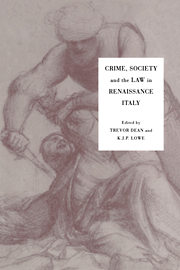Book contents
- Frontmatter
- Contents
- Illustrations
- List of contributors
- Preface
- 1 Writing the history of crime in the Italian Renaissance
- 2 Criminal justice in mid-fifteenth-century Bologna
- 3 The judicial system in Florence in the fourteenth and fifteenth centuries
- 4 The incidence of crime in Sicily in the mid fifteenth century: the evidence from composition records
- 5 Theology, nature and the law: sexual sin and sexual crime in Italy from the fourteenth to the seventeenth century
- 6 Practical problems in the enforcement of Italian sumptuary law, 1200–1500
- 7 The prince, the judges and the law: Cosimo I and sexual violence, 1558
- 8 Intervention by church and state in marriage disputes in sixteenth- and seventeenth-century Florence
- 9 The writer and the man. Real crimes and mitigating circumstances: il caso Cellini
- 10 The political crime of conspiracy in fifteenth- and sixteenth-century Rome
- 11 Fighting or flyting? Verbal duelling in mid-sixteenth-century Italy
- 12 Banditry and lawlessness on the Venetian Terraferma in the later Cinquecento
- 13 Mihi vindictam: aristocratic clans and rural communities in a feud in Friuli in the late fifteenth and early sixteenth centuries
- Index
9 - The writer and the man. Real crimes and mitigating circumstances: il caso Cellini
Published online by Cambridge University Press: 14 October 2009
- Frontmatter
- Contents
- Illustrations
- List of contributors
- Preface
- 1 Writing the history of crime in the Italian Renaissance
- 2 Criminal justice in mid-fifteenth-century Bologna
- 3 The judicial system in Florence in the fourteenth and fifteenth centuries
- 4 The incidence of crime in Sicily in the mid fifteenth century: the evidence from composition records
- 5 Theology, nature and the law: sexual sin and sexual crime in Italy from the fourteenth to the seventeenth century
- 6 Practical problems in the enforcement of Italian sumptuary law, 1200–1500
- 7 The prince, the judges and the law: Cosimo I and sexual violence, 1558
- 8 Intervention by church and state in marriage disputes in sixteenth- and seventeenth-century Florence
- 9 The writer and the man. Real crimes and mitigating circumstances: il caso Cellini
- 10 The political crime of conspiracy in fifteenth- and sixteenth-century Rome
- 11 Fighting or flyting? Verbal duelling in mid-sixteenth-century Italy
- 12 Banditry and lawlessness on the Venetian Terraferma in the later Cinquecento
- 13 Mihi vindictam: aristocratic clans and rural communities in a feud in Friuli in the late fifteenth and early sixteenth centuries
- Index
Summary
Benvenuto Cellini was a Florentine silversmith, goldsmith, sculptor, architect, thief, murderer and sodomite, in short the kind of character we would hold up today as an example of that fictitious academic construct, Renaissance Man. He was born in Florence in Borgo San Lorenzo, behind what is now the meat and vegetable market, at the beginning of November 1500. In 1513 he began his apprenticeship as a goldsmith, and in 1518 paid his first visit to Rome. He returned to his native city in 1521 but soon fell foul of the law and had to flee to Rome, where he entered the service of the Medici pope, Clement VII.
In his Autobiography we learn that he was involved in the cataclysmic Sack of Rome in 1527, where, according to his own account, he committed mayhem on the unfortunate enemy. On the death of Clement in 1534 and the election of the Farnese pope, Paul III, Cellini continued to work on papal commissions, though without the patronage he enjoyed under the Medici pope. In 1538 he was imprisoned and released only after pressure had been put on the authorities by influential and powerful patrons.
Needless to say, he left Rome as quickly as possible and meandered through the peninsula ending up in France, where he finally entered the service of the king, Francis I, in 1540. Despite a number of important commissions, including the exquisite Salt Cellar, he left Paris in despair and returned to Florence in 1545.
- Type
- Chapter
- Information
- Crime, Society and the Law in Renaissance Italy , pp. 157 - 183Publisher: Cambridge University PressPrint publication year: 1994
- 2
- Cited by

